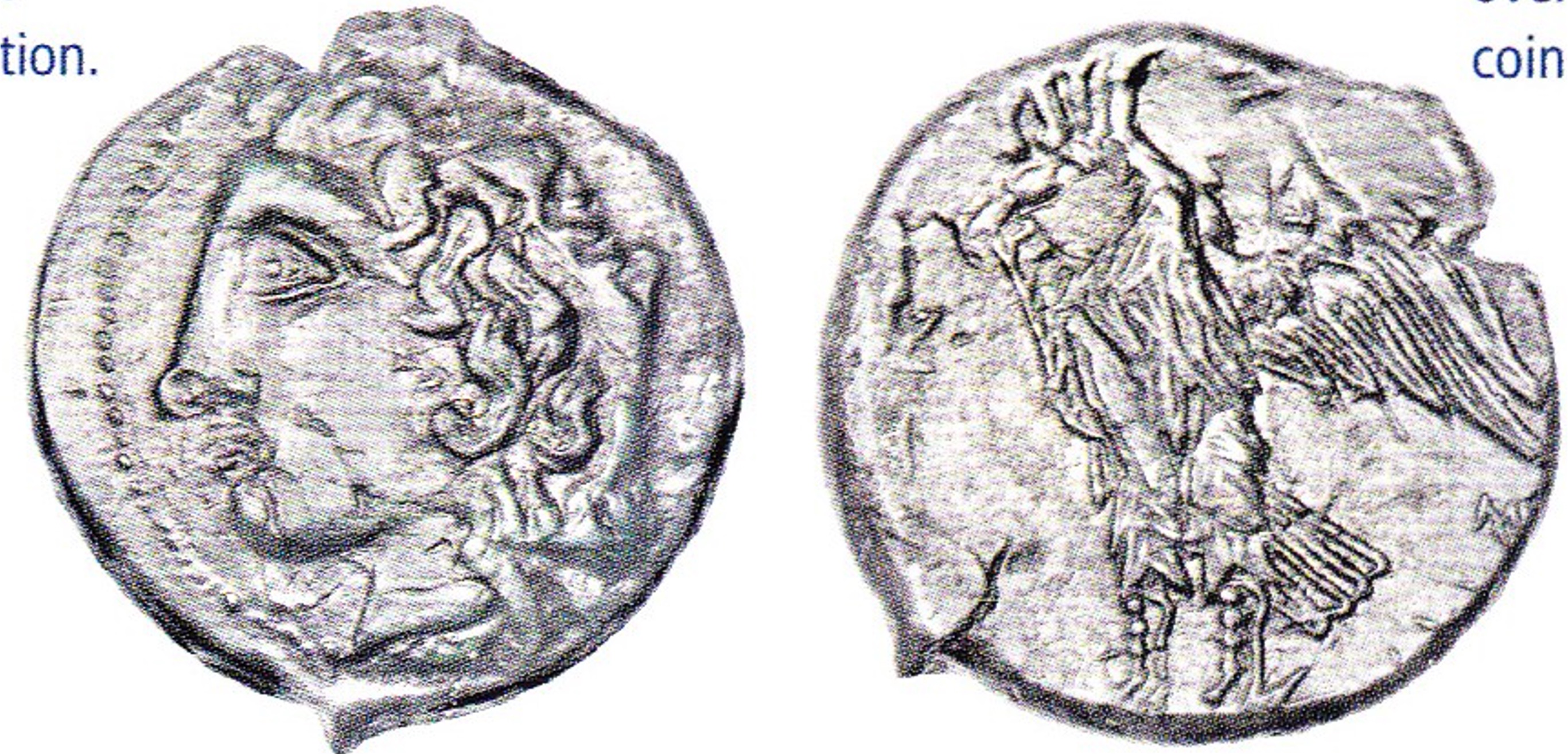287 BCE - 278 BCE | ΣΥΡΑΚΟΣΙΩΝ
Overstriking coin
SO_1670_-_Syracuse_(AE_Zeus-eagle).jpg
Overstruck variety
Syracuse Persephone-biga HGC 2 1446.jpeg
[1]
1670_Syracuse_Persephone-biga_(drawing).jpg
Description
| ObverseInscription or printing placed on the obverse.:
|
Head of Zeus left. Border of dots.
|
ReverseInscription or printing placed on the reverse.:
|
ΣΥΡΑΚΟΣΙΩΝ (Greek) Eagle standing left on thunderbolt, with opened wings.
|
Mint and issuing power
| MintIdentifies the place of manufacture or issue of a numismatic object.:
|
Syracuse
|
Ancient regionAncient region.
|
Sicily
|
Modern countryModern country: Italy
|
AuthorityIdentifies the issuing power. The authority can be "pretended" when the name or the portrait of X is on the coin but he/she was not the issuing power. It can also be "uncertain" when there is no mention of X on the coin but he/she was the issuing power according to the historical sources:
|
Hicetas (tyrant of Syracuse, 288-279 BC)
|
Chronology
| FromIdentifies the initial date in a range assigned in a numismatic context. 287 BCE toIdentifies the final date in a range assigned in a numismatic context.. 278 BCE
|
Classical 480-323 BC  periodTime period of the numismatic object. periodTime period of the numismatic object.
|
Physical description
MetalThe physical material (usually metal) from which an object is made.: Bronze 
|
WeightWeight of the numismatic object (in grams). in grams: 6.866.86 g <br />6,860 mg <br />
|
DenominationTerm indicating the value of a numismatic object. Examples: tetradrachm, chalkous, denarius.: denomination A/B
|
AxisDescribes the directional relationship between the obverse and reverse of a numismatic object.: 1010 mm <br />1 cm <br />
|
| DiameterDescribes diameter of an object (in mm).: 2020 mm <br />2 cm <br />
|
|
References
Description
| ObverseInscription or printing placed on the obverse.:
|
ΣΥΡΑΚΟΣΙΩΝ (Greek) Head of Persephone left. Behin, symbol (visible on obverse: profile of Persephone from forehead to neck, Ω, traces of other letters).
|
ReverseInscription or printing placed on the reverse.:
|
Biga driven by Nike galloping right (visible on reverse: heads and legs of horses, trace of letter or symbol).
|
Mint and issuing power
Chronology
| FromIdentifies the initial date in a range assigned in a numismatic context. 287 BCE toIdentifies the final date in a range assigned in a numismatic context.. 278 BCE
|
Hellenistic 323-30 BC  periodTime period of the numismatic object. periodTime period of the numismatic object.
|
Physical description
| DenominationTerm indicating the value of a numismatic object. Examples: tetradrachm, chalkous, denarius. ᵖ:
|
denomination A/B or B
|
|
|
References
References
- a b Calciati, Romolo (1986), Corpus nummorum siculorum. La monetazione di bronzo/The bronze coinage, vol. 2, Milan, Edizioni G. M.
- a b Hoover, Oliver D. (2012), The Handbook of Greek Coinage Series. 2. Handbook of the Coins of Sicily (Including Lipara). Civic, Royal, Siculo-Punic, and Romano-Sicilian Issues. Sixth to First Centuries BC, Lancaster-London, 489 p.
- a b Puglisi, Mariangela (2009), La Sicilia da Dionisio I a Sesto Pompeo : circolazione e funzione della moneta, Messina, DiScAM, p. 519.
 Traces of the overstruck variety
Traces of the overstruck variety

